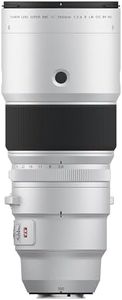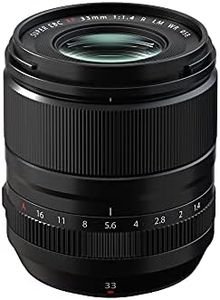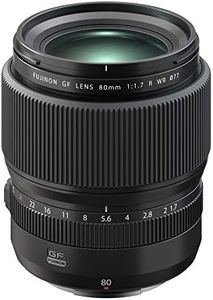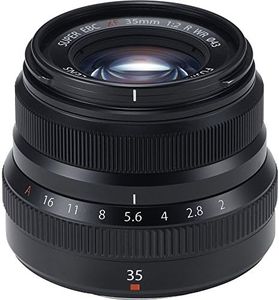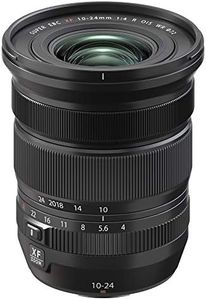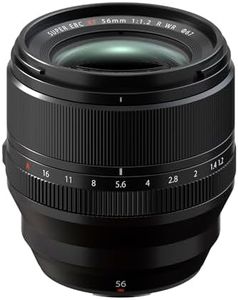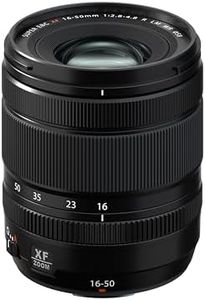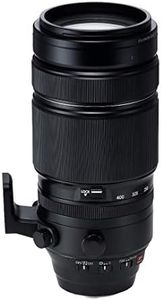We Use CookiesWe use cookies to enhance the security, performance,
functionality and for analytical and promotional activities. By continuing to browse this site you
are agreeing to our privacy policy
10 Best Fujifilm Lenses
From leading brands and best sellers available on the web.By clicking on a link to a third party's website, log data is shared with that third party.
Buying Guide for the Best Fujifilm Lenses
When choosing a Fujifilm lens, it's important to match the lens capabilities with your photography needs and style. Fujifilm offers a wide selection, from compact prime lenses to versatile zooms, each designed for different shooting situations. Understanding what you hope to photograph most—such as landscapes, portraits, or sports—will make it easier to narrow down your options. By focusing on the key specs of each lens, you can find one that best supports your creative goals, is convenient to use, and pairs well with your camera body.Focal LengthFocal length, measured in millimeters, tells you how 'zoomed in' a lens appears and how much of a scene it can capture. Shorter focal lengths (like 16mm or 23mm) are wide-angle, great for landscapes or architecture, offering a broader view. Standard focal lengths (about 35mm to 56mm) mimic what the human eye sees and are versatile for everyday and portrait shots. Longer focal lengths (such as 80mm or above) are telephoto, pulling distant subjects closer and creating strong background blur, which is perfect for wildlife, sports, or isolated portraits. Think about what you photograph most and choose a focal length fitting that situation: wide for groups and scenery, mid-range for street or portraits, and telephoto for distant subjects.
Aperture (Maximum F-Stop)Aperture refers to how wide the lens can open to let light in, expressed as an f-stop number like f/1.4 or f/2.8. A lower f-stop (like f/1.2 or f/2) means more light can enter, which helps in low-light settings and allows for a blurred background (bokeh). Higher f-numbers (like f/4 or f/5.6) mean less light and a deeper focus area, which can be useful for landscapes. If you like shooting in dim environments or want beautifully blurred backgrounds, look for lenses with wider (smaller number) maximum apertures. For travel and daylight shooting, an average aperture works well.
Lens Type: Prime vs. ZoomPrime lenses have a single fixed focal length and are often lighter, sharper, and faster (wider aperture) compared to zooms. They're great if you know the exact style or subject you want. Zoom lenses cover a range of focal lengths, offering flexibility to quickly reframe without switching lenses, which is great for travel or events with changing subjects. Choose a prime lens if you prioritize image quality and know your subject, or a zoom if you value convenience and versatility.
Image StabilizationSome lenses include built-in stabilization (OIS with Fujifilm) to reduce blur caused by camera shake, especially helpful in telephoto lenses or low-light situations. If you often shoot handheld in low light or at long focal lengths, a stabilized lens lets you get sharp photos without needing a tripod. If you usually use a tripod or shoot wide-angle in good light, this feature is less essential.
Autofocus Speed and NoiseAutofocus speed determines how quickly a lens locks onto a subject. Fast autofocus is important for capturing action, wildlife, or moving people, while noiseless focusing is valuable in quiet settings, like during events or shooting video. If you plan to photograph fast action or need silent operation, check for lenses noted for quick and quiet autofocus performance. For static subjects, slower or slightly noisier focus might be acceptable.
Size and WeightLenses differ greatly in size and weight. Smaller, lighter lenses are easier to carry for travel or street photography and less noticeable. Larger lenses can be heavier but sometimes offer higher quality optics or longer zooms. Think about your comfort in carrying your camera for hours. For portability, choose more compact lenses; for specialized use (like sports or wildlife), you might accept a larger lens.
Weather SealingSome lenses are built to resist dust and moisture, which is called weather sealing. This is essential if you plan to photograph outdoors in unpredictable conditions, such as in rain, snow, or dusty areas. If your photography keeps you mainly indoors or in mild weather, this feature might not be as important.
